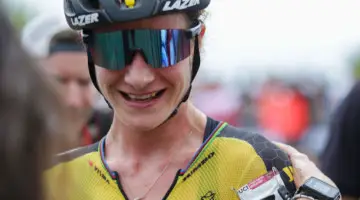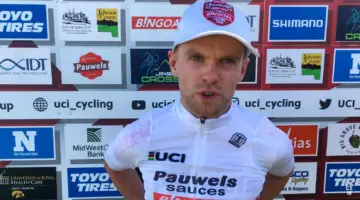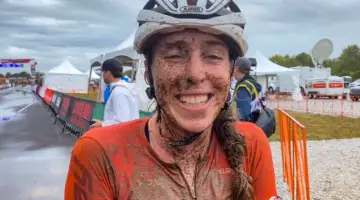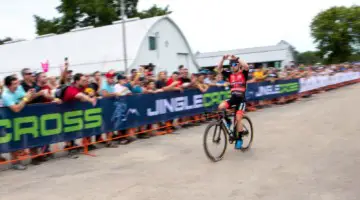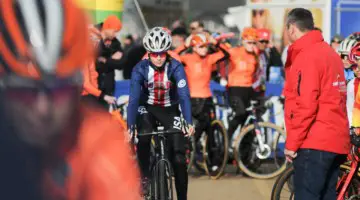Thus far in our behind-the-scenes look at U.S. cyclocross, we have taken a peek inside the life of a race announcer and team manager, and today, we get a chance to catch up with one of the race directors who helps make one of the biggest races in the U.S. happen each year.
John Meehan started Jingle Cross in Iowa City 16 years ago when he was working as an pediatric surgeon at the University of Iowa Hospital. With a fun play on its then-wintry setting, Meehan—and his alter ego, the Grinch—turned Jingle Cross into a Midwest cyclocross festival with close ties to the Iowa City community.
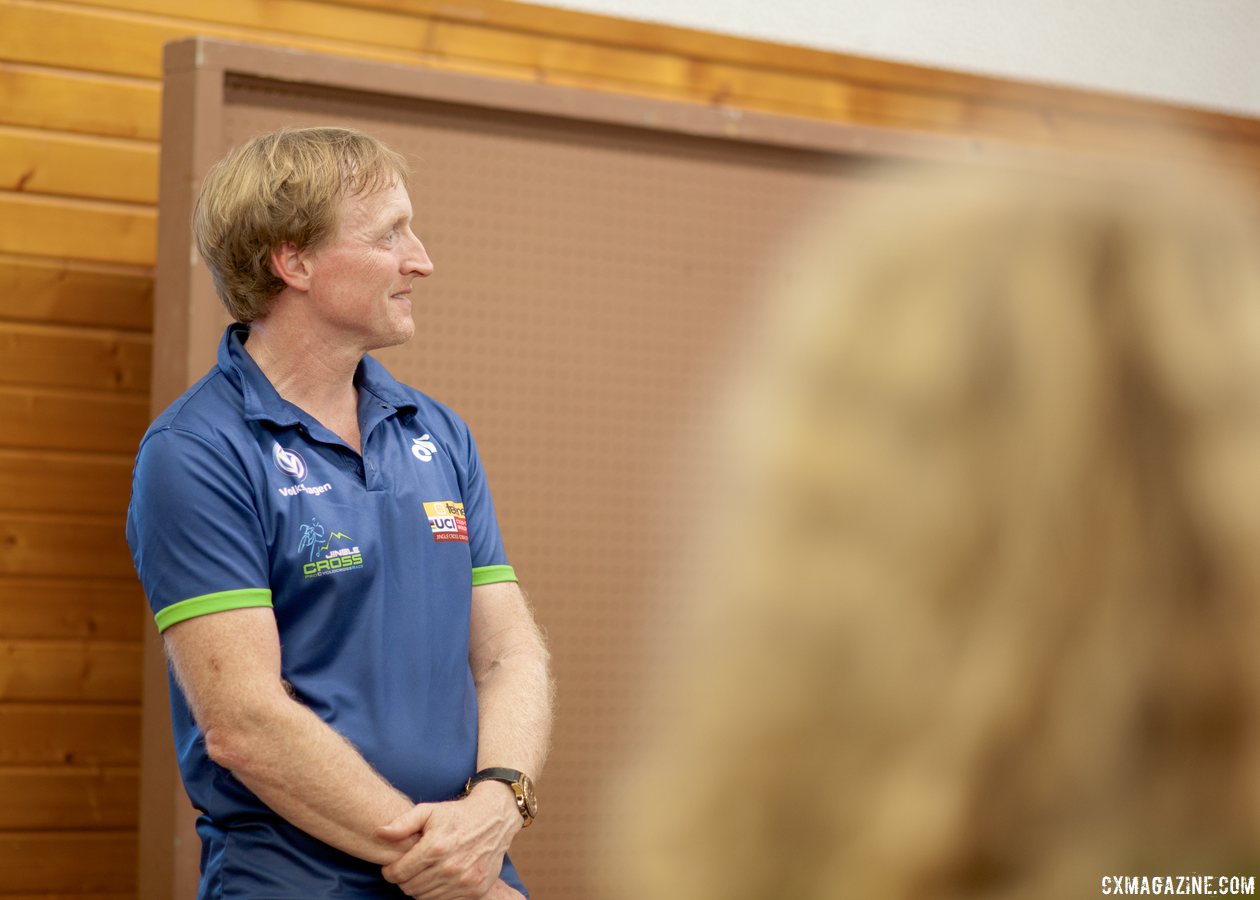
John Meehan has been the Jingle Cross race director since its start a decade and a half ago.. 2016 Jingle Cross cyclocross festival. © A. Yee / Cyclocross Magazine
Since its inception, the race has served as a benefit for the University of Iowa Stead Family Children’s Hospital, and that close connection continues to this day.
“The people in Iowa are quite unique. They are very dedicated and have a passion for their community and also a huge passion for cycling and cyclocross,” Meehan said. “Above that, they are also very dedicated to the kids [at the University of Iowa Stead Family Children’s Hospital] and kids in general. Whether it’s our Grinch’s Kids race, the Junior Devo Cup that we’ve now got or our charity for the Children’s Hospital, they’ve always been really rallying around that.”
Four years ago, Meehan and his team of volunteers from Iowa City elevated the annual Midwest race to UCI World Cup status. Although Meehan now lives and works in Seattle, keeping the race in Iowa has been important for him, even if it has made his life a bit more difficult.
“I choose to do this in Iowa, even though it’s a smaller town and a long way away and hard on my family because I just love the event,” he said. “It’s hard to pass it up. It’s too much fun.”
This year marks Year 16 for Jingle Cross and Year 4 as a World Cup. I chatted with Meehan about his role as race director, how the Jingle Cross team puts the race on each year and a bit about what’s new for 2019. You can read a transcript of our conversation below.
For more info about the 2019 Jingle Cross festival and its events, visit jinglecross.com.
Interview: John Meehan, Jingle Cross Race Director
Cyclocross Magazine: You guys are bringing Jingle Cross back as a World Cup for Year 4. What are your thoughts on how things are going and bringing it back as a World Cup for another year?
John Meehan: This is our 16th year as Jingle Cross and our 4th as a UCI World Cup, so we’re very excited to be able to continue to bring a high-quality, international World Cup to North America again. We have had a great experience with the UCI and all the international riders, and we really enjoy bringing this to the Iowa community.
CXM: The event is very volunteer-led, you have a day job and do it on the side, how is that process each year in terms of deciding if you’re going to apply for a World Cup the following year?
JM: The people in Iowa are quite unique. They are very dedicated and have a passion for their community and also a huge passion for cycling and cyclocross. Above that, they are also very dedicated to the kids [at the University of Iowa Stead Family Children’s Hospital] and kids in general. Whether it’s our Grinch’s Kids race, the Junior Devo Cup that we’ve now got or our charity for the Children’s Hospital, they’ve always been really rallying around that.
Through it, we’ve grown into a huge event plus a World Cup. The people there are so excited to do this every year. Finding volunteers is always a challenge, but every year, they’re always there. They work so hard on this year-round.
What’s even more challenging this year is the race is on the same day as the Iowa-Iowa State game in Ames. It’s not in Iowa City, it’s in Ames, but it’s like trying to do a World Cup in Belgium on the same day Netherlands is playing Belgium in the soccer World Cup. And yet I still have a ton of volunteers helping us put this together.
CXM: You touched on a couple things I wanted to ask about. One, the Devo Cup was a really cool thing you introduced last year. How did that end up working out?
JM: Huge. I mean we had kids from all over the U.S. come and ride. What’s really unique about that is we put that as our last biking event right before the World Cup. The crowds were the biggest, and they are really excited to get ready for the World Cup, and here they are watching all the Juniors and they got behind them. I think the kids really really appreciated it.
What’s even cooler for the kids is they’ve got all the pros kind of watching them while they’re off on the side. It was really cool to see that happen. A lot of the pros were probably like, “Watch these guys. That’s what’s coming for me next. I’m in trouble.”
CXM: Also, to tell a story, I remember back in the day before Trek took over the Trek CXC Cup, I always volunteered helping out the race director, and I remember we would sit around asking, “What can we do to be like Jingle Cross? That race is so dialed.” And one of the things I thought you did really well was building partnerships in the community. What has it taken to maintain the great partnerships that help you put on the event?
JM: You know, the community really rallies around it. We don’t really have huge international, or really even national, sponsors for it. Obviously we have some cycling companies, but we do get a lot locally. We have bike shops from across the state and even as far away as Chicago and the other side of Iowa coming to help put on the event because they see the value in it for the entire Midwest community.
I look at this as not just a Iowa City event, not just an Iowa event, but it’s something for the Midwest. We’re able to put this on just because people get it. They have the passion, and they want to see it keep coming back.
CXM: I was convincing someone to Jingle Cross this year, and I was like, “You need to do the World Cup, but also down the road if it happens to be back in November or December, you need to go then.” And last year I really felt the vibe reminded me of the days back when it was in November, December. How have you fostered that Midwestern fun, festival vibe at the race?
JM: You just hit on the key thing. It’s not just a bike race, it has to be a festival. It has to have more going on than just a bike race. I’ve participated in a lot of bike races here in Seattle where I live, and they’re great races, but there’s nothing there to keep you there all day. You ride your race and go home. That’s why for some of the pro races, the crowds thin out by race time.
What we’re tried to do is make it all-encompassing. All the food is here, all the entertainment, beer, wine, shower facilities. Everything is here so you can race, spend your day with us and cheer on your friends while having a good day and a good party atmosphere. There just happens to be a World Cup going on in the middle of this party. That’s the attitude you take.
You have to offer something for the families because you know riders are going to bring their kids. What about people with their dogs? They can’t leave their dogs at home all day, so we have a Doggie ‘Cross.
This year, the new thing we’re offering a cross country run. The Jingle Cross Country Run is a Super Hero run. You dress up as your favorite super hero, whether it’s Elastagirl or Batman or Superman or whatever, and we’re going to have a 4k cross-country run on part of our cyclocross course.
CXM: Really? Does that include Mt. Krumpit?
JM: Part of it will if the weather is good. We’re going to have to dial it in so we don’t damage the course with a bunch of runners or anything. It’s going to include sections of the course, and it’s going to be really fun and exciting.
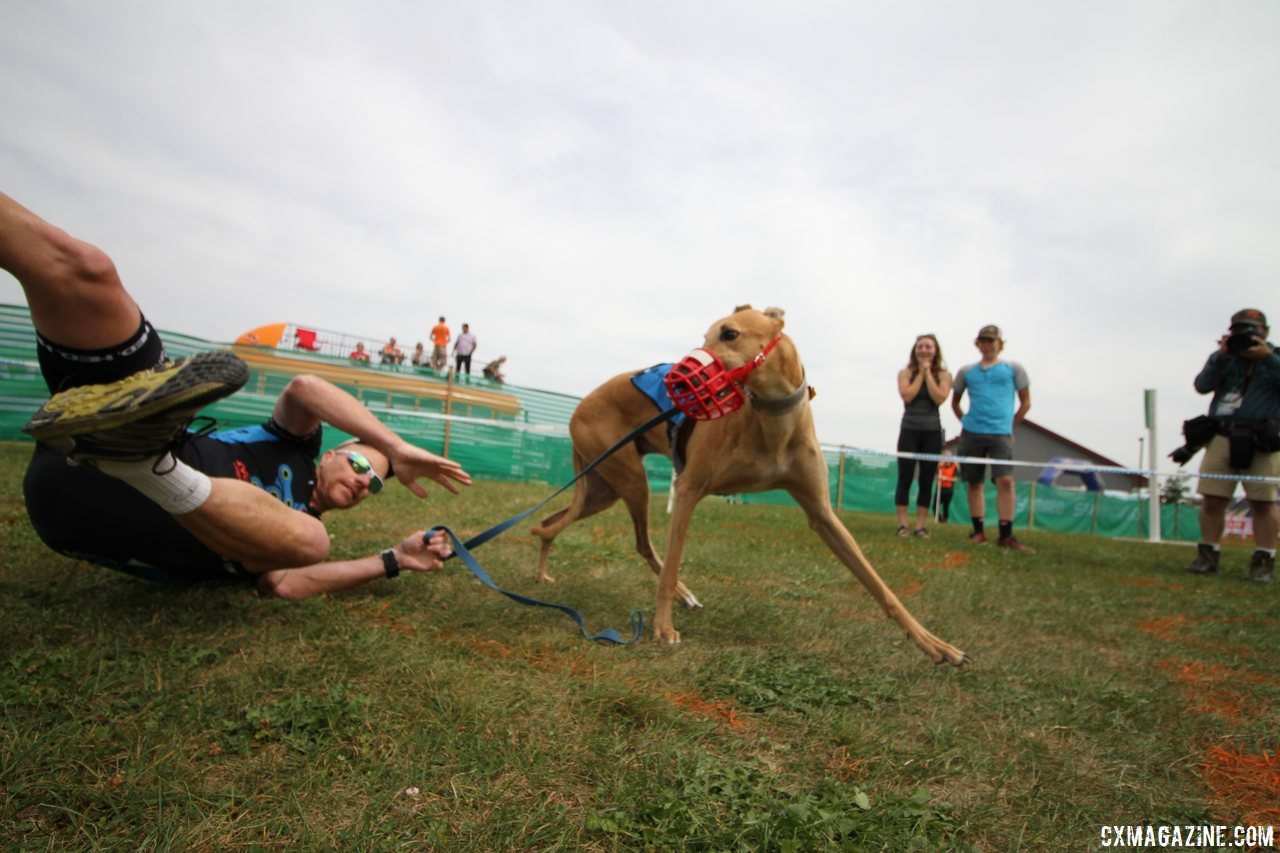
The Doggie Cross will be back at Jingle Cross this year. 2017 Jingle Cross World Cup © D. Mable / Cyclocross Magazine
CXM: You’ve been introducing new stuff every year it seems like. Does that come from your team? Do you just sit around coming up with new and interesting events to add?
JM: The Doggie Cross was my idea, but the run is something we’ve been toying around with for about five years now. I can’t say I was the first one who came up with the idea. But when we’ve brought it up, we’ve said, “How are we going to pull that off? I mean, we’re so busy with all this other stuff.” Finally this year, we decided we’re going to do it.
A few years ago, we had a gravel and road event, but what we realized is we spread ourselves too thin with that. People wanted to do the gravel, but they didn’t really want to do the road. We were trying to do both at the same time, and it didn’t really work out. This last year we decided to regroup and bring back the gravel event, but it has to have a purpose, it has to have a theme.
The gravel event we put together is really intended to bring in people who don’t race cyclocross but might want to come watch it. The goal is to entice them to come watch. We’re doing a poker and beer themed gravel ride, obviously for the adults, and we’re lucky enough to have Riverside Casino as one of our sponsors. Eight o’clock on Saturday morning you’ll leave the [Johnson County] Fairgrounds and ride out to the Kalona Brewing Company, and you’ll get a complementary beer and poker cards. Then you circle back to Big Grove Brewery in Iowa City for another beer and more poker cards, and then come back to the Fairgrounds and have a Deschutes beer at the race.
Then you pick up poker cards along the way. At the end, you can win some swag with a good hand. That’s what we’re doing this year, and we think it’s going to be very exciting.
CXM: One thing we are seeing is big changes in the U.S. cyclocross landscape. You guys are still going to be a C1 on Sunday, thanks in part to the number of international riders who will be there for the World Cup. What do you see for UCI racing in the U.S. in the next couple of years, and what can we do to keep our scene strong?
JM: Obviously I think cyclocross is a really exciting event to watch as a spectator. I think the crowds need to come see it, and once they do, they think that’s crazy, that’s wild, I want to participate in that. I think it has the potential to continue to grow and be that entry-level thing if you want to do it.
I look at cyclocross a lot like a 5k fun run. You’re out there doing the 5k for 20, 30 minutes, and in cyclocross at the Cat 4/5 level, they’re 30-minute races and it’s kind of the same idea. It’s in a park, it’s low-key and it’s a fun party afterward. I think this is the way to keep people involved at higher levels, not just running or jogging but racing, if you’re a runner.
For cycling, it means instead of just riding on the road or gravel, you’re getting some extra activity, and you have something to look forward to and participate in at a higher level for yourself.
And then you get to watch the pros. It’s really cool. This is like going to Yankee Stadium, and first you and your friends play a pickup softball game, and then you watch the Yankees and Dodgers in the World Series or something like that. It’s really cool.
CXM: We just had the CrossFit Games here in Madison, and that’s part of their deal. I was talking to my partner about it, and it was like, it seems a lot like ’cross. In their case, they go and lift weights and stuff and then watch the folks who are really really good at it.
Speaking of your Yankee Stadium, you guys have dialed your course in. I think there’s a consensus that it’s a “World Cup course.” It’s really hard. But you did change the Krumpit descent a bit last year. What is your process like for putting together the course each year? What are some of the things your team thinks about?
JM: One of the considerations we have now that we’re at the World Cup level, you want some consistency for the television production part of it. The producers need to know what to expect going into it. They’ve seen the course for three years now, and they know the camera angles to deliver to get the fans excited watching at home on tv or the live stream. You have to keep that part of it in mind.
At the same time, you want to make sure it’s challenging. Every year we are tweaking the course. We’re looking first of all at safety. Safety is far and away our primary concern. Weather changes might make us change the course a little bit. Also, you’ll notice when we’re having amateur races, certain parts of the course are not used for some of those races. We’re always really really attuned to safety because it is so important to us.
Last year we changed the downhill a little bit thinking it would be a little more interesting, technical and better. In retrospect, we think the way we had it in prior years was better for one section, and then what we did last year in another area was better. It’s kind of a learning process, and we’re going to make some changes on the Krumpit descent this year to make it better and more exciting for the riders. We want to make sure the riders are safe, but we also want to make sure they have fun going down. It’s a fun descent.
My course captain, Ben Anderson, is absolutely amazing. His team and him spend a lot of time trying to make that just right. They’ve talked about it starting at the end of last year’s World Cup. When one World Cup ends, they’re talking about the next year. What worked, what didn’t work, what can we do to make it better? We’ve already got a great plan for this year.
CXM: I remember rolling up to the venue last year and being like, “Whoa, the Krumpit descent changed!” It was really awesome on Saturday the day of the race, Tim Johnson, who has done Jingle Cross a few times, he was coaching both the American and international riders on the descent. They were gathering around him to hear him point out the lines and give advice. I think it was cool to see someone who has a lot of experience at Jingle Cross helping coach the next generation. It’s a special thing about your race.
JM: It’s very much my opinion that our World Cup course is not won on the ascent up Mt. Krumpit, it’s won on the descent. That descent is tricky, and you need to know how to ride it and ride it properly. The riders who figure that out, who get the right lines and right momentum through the turns are the ones who are going to win the race. It’s critical.
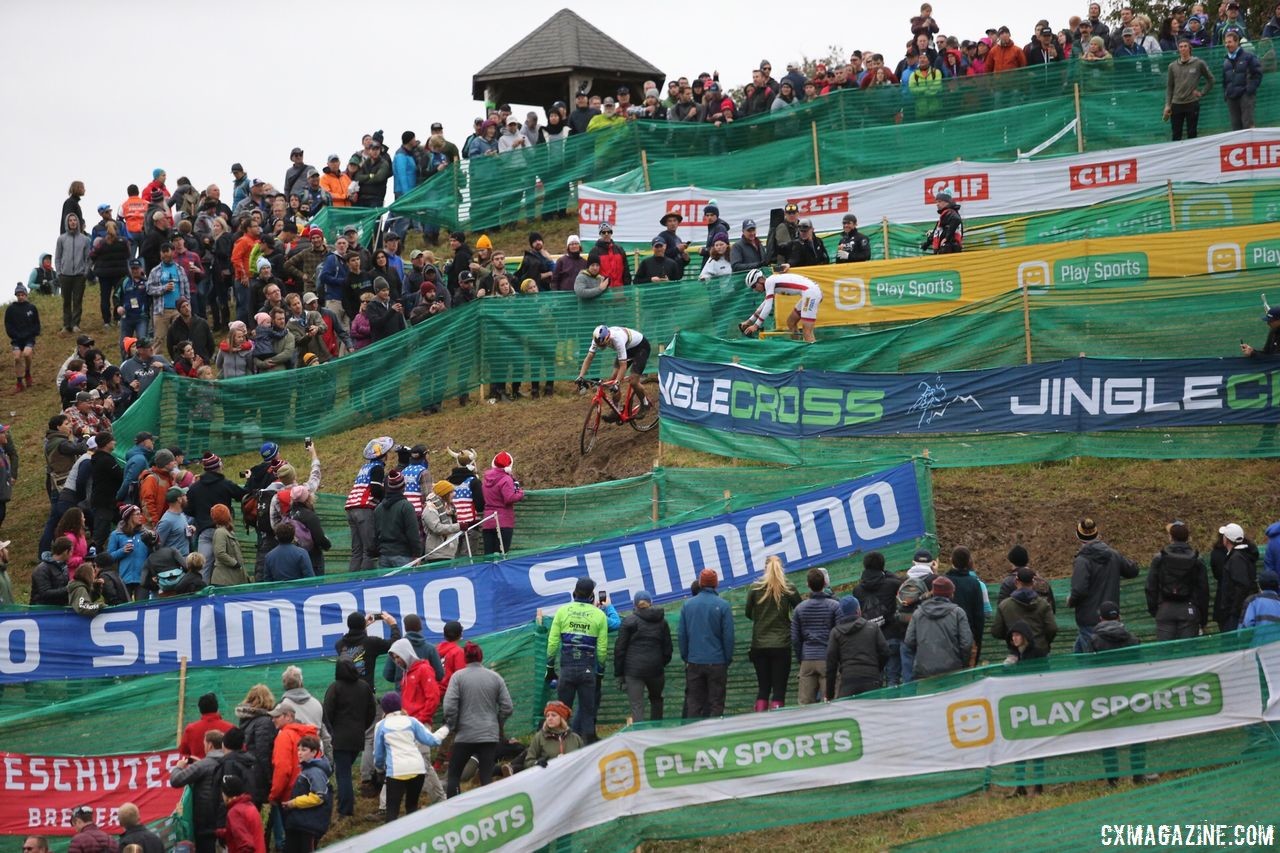
Organizers switched up the Mt. Krumpit descent in 2018. 2018 Jingle Cross World Cup. © J. Corcoran / Cyclocross Magazine
CXM: You talked about your team doing a debrief about the course after the race. Do you have a formal process for doing your debrief, how you make note of things you learned knowing the next race is still a year away?
JM: At the end of the race, we’ll get together that night and pass ideas around, and then talk a little bit more the next day when amateurs are riding on the course. That’s another thing we have for Sunday, the amateurs ride the World Cup course, so we get to look at how the course holds up. How other people ride it at different levels, obviously taking out the super-dangerous areas for the less experienced amateurs.
The really key thing is the following morning, breakdown day on Monday, we start sharing ideas and passing emails around to each other once we get a few days out. There is a huge process of learning and improving. We do a lot with that.
CXM: Last time I talked with you was in 2017, and we talked about the crazy storm in 2016. I think we concluded that was the biggest challenge of the first World Cup year. What is the biggest takeaway from last year’s Jingle Cross for you guys?
JM: Last year, as many people know, one of our announcers made derogatory comments about female athletes. That was very difficult, first and foremost, because it happened at our event and does not represent the Jingle Cross organization or the values of anyone who works or volunteers for us. Secondarily it was difficult because of the fallout. We are a non profit organization run entirely by volunteers, and we take a lot of pride in doing our best to raise funds and host this great event.
During the event, I’m not always listening to the announcers because I’m running around the course helping make sure everything is running smoothly, or I’m on my radio which is constantly going off, or I’m talking with officials or someone else. Likewise my incredibly busy crew is doing the same. We can’t hear every word announcers say, and anyone who’s ever put on an event knows that’s impossible.
But everyone with the Jingle Cross organization learned a big lesson last year, and we felt we addressed the issue as quickly as possible once we learned of it, which unfortunately was not until the event was over. When you’re a volunteer, it’s hard to hear the negative comments directed at you personally.
But let me make clear, I understand and acknowledge it was also a very painful experience for our riders, guests, and spectators to hear what was being said during their race. The announcer in question will not work with our organization again.
CXM: I am sorry for everything you personally had to deal with from last year. I guess it would be different if you were making a ton of money as a race director, but you’re just a volunteer flying back and forth from Seattle to put on the race.
JM: Yes, and I also totally believe in equal prize money for men and women. We did it for many years for the C1 and C2 events before it was a rule. But we just don’t have the money when we are talking about the huge gap in the World Cup. Last year it was about a $30,000 difference. It’s less of a difference this year because the UCI is going to incrementally even it out and they’ve thankfully started that process. This year it’s about $25,000, so they are appropriately closing the gap.
I spent all year trying to raise additional funds. But the Jingle Cross organization can’t cover that gap. Every year of our 16-year existence, Jingle Cross has donated all proceeds to the University of Iowa Stead Family Children’s Hospital. We’re on such a tight rope. It’s a year-long process of adjusting the budget just to make the World Cup work.
CXM: As a race director, are you seeing where having time to plan for the increase in payouts to the women at least gives you a fighting shot to raise the extra money?
JM: First of all, Trek Corporation is a 900 million dollar corporation with 1,800 stores in the U.S. alone, and they should absolutely be congratulated and commended for equaling the prize money for the men and women. It is a great thing to do, and we fully support it.
For us to all of a sudden switch and do that, it’s impossible. We don’t have anything other than this race. The only way we make money is rider registration fees and a few small sponsorships. We also sell a little bit of merchandise, but that doesn’t cover much. For us to make that kind of money off one weekend and cover that gap is incredibly challenging to make it happen in one year.
The way the UCI is doing this over a four-year period is helpful to us because we can gauge what we can cut from the budget and how we can raise revenues. That’s why we added the gravel ride and cross-country run, to make the additional thousands of dollars we need to meet the UCI payout requirements for this year because they’re closing the gap, which is great. We are adding things to try to increase revenue, and that’s how we’ll be able to do it.
To have to do it in one step would have been really hard, so I like this gradation process. It’s going to help us get us to the new norm, which is what I think is appropriate.
CXM: You’ve put on a race a few times before, so some things have to be pretty dialed by now. As a race director, what changes and what occupies your time from one year to the next in terms of putting on the next year’s race?
JM: Oh my gosh, finding sponsors. Finding sponsors. That is a huge huge huge task. Iowa City is a small town. Cedar Rapids is 25 minutes away, but might as well be 200 miles and 3 hours away. The city of Iowa City is making this happen, and the majority of our sponsors are from that area. It’s a small town, so it’s hard.
Once we know we’re going to go forward with the World Cup, I am immediate in contact with my existing sponsors to gauge their level of interest for the upcoming year. Then, I’m immediately trying to find new ones. A lot of it is cold-calling, and they don’t know you from anyone else. You just have to keep working at it. Meanwhile, I have a full-time job and a family and other obligations. That process is really long. When this race is over, I’m starting in October, and I’m still working on it now.
CXM: So why do you do it? What motivates you to be a race director?
JM: Probably crashing my bike without a helmet on one too many times.
I don’t know, I just enjoy it. I’m a pediatric surgeon now, and my whole career is thanks to the University of Iowa Medical School, and after I did all my residencies and training across the nation, I came back and my first job as a pediatric surgeon was there. I got started in robotic surgery, and now I teach robotic surgery all over the world.
My entire career, where I am at, is thanks to the University of Iowa. Even though I don’t live there anymore, I am dedicated to a great group of people and a great institution. When people ask me, “Where are your friends?” My response is, “They’re in Iowa City.” They’re the greatest people I know.
CXM: I think it’s incredibly cool to see the connection you have with that community, that you’ve chosen to keep the race going in Iowa City, instead of moving your race to Seattle and saying, we’ll call it, what’s a holiday where it rains a lot?
JM: Yeah, there are amazing companies here in Seattle. There’s the Big Five, Boeing, Microsoft, Costco, Amazon and Starbucks, and between all of those and tons more, there is a tremendous amount of wealth and ability for events like this. But I choose to do this in Iowa, even though it’s a smaller town and a long way away and hard on my family because I just love the event. It’s hard to pass it up. It’s too much fun.
CXM: With all the experience you’ve had, maybe there are some people out there who are crazy enough to want to be a race director, what are the most important skills to have or work on?
JM: The first year we put on the World Cup, I learned you have to be willing to let your team help you. Don’t try to do everything yourself. I rely on a lot of people in surgery who do great things, but you can still get a mentality where, “I’ll just take care of this.” You can’t. You can’t do it all. You have to find the right people and let them run.
My team does an amazing job, and that’s why this race is successful. There are hundreds of people who help us put this race on. There is a core group of about 20 who are just unbelievably smart, dedicated and resourceful and can make things happen. I think the world of all of them. They’re the reason we’re successful. I just make phone calls.
CXM: We get to work with Tricia Brown in the media center, and she is great at her job. I would imagine her abilities are multiplied 20 times over with your team, and that’s gotta be huge for making things work well.
JM: You know what, they’re the reason the race is successful. I’m just the one who’s crazy enough to try and make it keep happening.
CXM: I saw you guys had a good contingent in Denmark. What were your thoughts on the World Championships?
JM: That was fun. That was great. I like to take a little bit of my crew to the World Championships when we can. We go there to watch and learn a little bit, but also to go and have a good time and relax. We’re there to learn, but we’re also there to let the world know that Jingle Cross is here. We’re coming as a team.
CXM: You guys were easy to spot with the iconic jackets you have created. I kept coming across the Jingle Cross people in Bogense. They are definitely in the house.
JM: Yep, we are there.
CXM: Well thanks so much. I’m excited to see you again in a month. The Grinch will be there?
JM: I’ve heard rumors. I’ve heard rumors the Grinch just might show up. Between the Kids’ race and the Doggie Cross, he’ll probably show up somewhere.

The Grinch will likely be back in 2019. 2016 Jingle Cross cyclocross festival. © A. Yee / Cyclocross Magazine
CXM: I know a few years ago you were dealing with a break or something like that. Are you healthy? Are you going to jump in a race somewhere?
JM: Yeah, I’m healthy. I’ll at least make a few laps. I’ll probably be the guy, I think they call him DFL. That will be me.
CXM: Thanks again for your time. See you in Iowa City.
JM: You bet. Thank you.
























